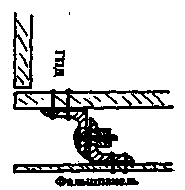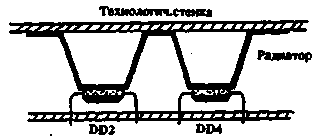
|
|
ENCYCLOPEDIA OF RADIO ELECTRONICS AND ELECTRICAL ENGINEERING From the experience of building TRX RA3AO. Encyclopedia of radio electronics and electrical engineering
Encyclopedia of radio electronics and electrical engineering / Civil radio communications Many radio amateurs are looking at the design of the V. Drozdov transceiver (RA3AO). I built two devices of this author and set up about a dozen GPA + DPKD units. In my opinion, you need to start with the chassis, power supplies, GPA and DPKD. Exactly in that order. When this task is completed, we can consider that 50% of the work is behind. Boards should be prepared as needed, gradually moving forward. The author's block of the GPA was made in good faith, but small deviations can be made. It is possible and necessary to partially change the method of fastening the GPA and the front false panel. The author provides for mounting with three M5 screws 22 mm long on the racks. The two upper screws should be left, and the third, lower one, covered by the PKU board, should be excluded along with the rack. Instead of them, put two L-shaped brackets, as shown in Fig. 1.
When repairing, such a fastening of the unit makes it easy to remove it from the case without soldering the PKU board. As a rule, it is not possible to start the GPA immediately, and there are many reasons for this. Unsuccessful selection of transistors can be one of them. VT1 must have a transmission coefficient of 200 or more, and only KT382A can do this. Violation of the mounting technology, poor quality of attachments, poor performance of the resonator and capacitor C4, low-grade fiberglass for the board, poor solder, sloppy soldering, rough power supplies - this is not a complete list of these reasons. In addition to the capacities indicated by the author, KLS, KLG, film and ceramic with zero TKE can also be used in the GPA circuit. In no case should CT capacitances be used, they give a "flicker" of frequency. About voltage stabilizers on the DPKD board KP302 transistors in the stabilizer circuits should be cold (to the touch). This is achieved by selecting resistors R23 and R50. In this case, the measurement of output voltages must be carried out with a digital voltmeter accurate to the third decimal place. If the third digit “jumps” within small limits, then the goal is achieved, and if the second digit “runs”, then it is still far away. If 30 - 40 minutes after turning on the transceiver, frequency drift appears again, then the stabilizers have nothing to do with it, it is necessary to improve the TKE of the elements of the GPA circuit. GPA transistors KT382A consume from 3 to 6 mA from each power source. Particular attention should be paid to the offset at the output from VT2. It can be measured with a conventional tester through a choke of 20 - 50 mN. There is a small "plug" from -1,05 to -1,32 V, and at the same time, the input ESL element of the DPKD successfully starts. Sometimes it is very difficult to get into the band of this "fork", both the resistor and the diode from the VT2 emitter circuit have already been removed, and the bias is still large. Then you can increase R2 to 91 - 100 ohms on the DPKD board or short one diode in both power supplies of the GPA and adjust the bias in a new way. A few words about DPKD The output from the emitter follower (VT12) to the frequency meter is best done through a capacitance of 0,033 microfarads. When setting up the frequency meter, there may be accidental short circuits to the case in this circuit and the VT12 transistor fails, and it is not easy to replace it if you do not do the above-described revision for fastening the GPA and the false panel. Solder the container from the side of the tracks near the XP1 connector, having previously cut the track to B16. If the plans for the future do not provide for the manufacture of a separate receiver, then the A15 board can be excluded, six holes for it in the front panel are not drilled and on the DPKD board (also from the side of the tracks) to the input 5 DD6 through a resistor 4,7 to apply -5,2, 500 V. ICs K141IR5,2 consume from a source of -170 V up to 80 mA each and at the same time heat up to 120'C and above. On some ranges in some areas they can be excited. It is easy to detect this phenomenon by blowing through the tube on the MS body. In this case, the excitement disappears. There is only one conclusion - a radiator is needed. An aluminum strip 1 mm long, 2 mm thick and slightly wider than the length of the MC cases is bent as shown in Fig. XNUMX, and with titanium paste is installed between the technological wall and the MC cases.
Author: N. Kisel (UA3AIC), Moscow Publication: N. Bolshakov, rf.atnn.ru
Machine for thinning flowers in gardens
02.05.2024 Advanced Infrared Microscope
02.05.2024 Air trap for insects
01.05.2024
▪ Hydroelectric power plants also warm up the climate ▪ Most Integrated Serial-to-Parallel Converters ▪ A camera that works like the retina of the human eye
▪ section of the site Security and safety. Article selection ▪ article Mortal sin. Popular expression ▪ article How was soil formed? Detailed answer ▪ article Golden varnish for tinplate. Simple recipes and tips ▪ article A drawing that paints itself. Focus Secret
Home page | Library | Articles | Website map | Site Reviews www.diagram.com.ua |






 Arabic
Arabic Bengali
Bengali Chinese
Chinese English
English French
French German
German Hebrew
Hebrew Hindi
Hindi Italian
Italian Japanese
Japanese Korean
Korean Malay
Malay Polish
Polish Portuguese
Portuguese Spanish
Spanish Turkish
Turkish Ukrainian
Ukrainian Vietnamese
Vietnamese


 Leave your comment on this article:
Leave your comment on this article: